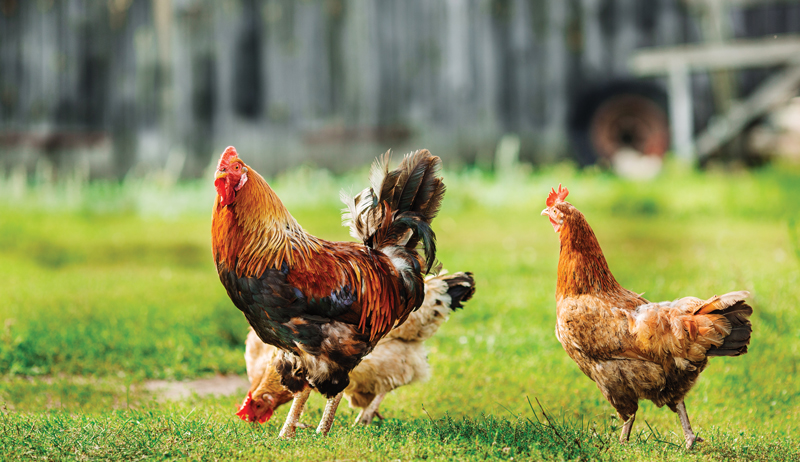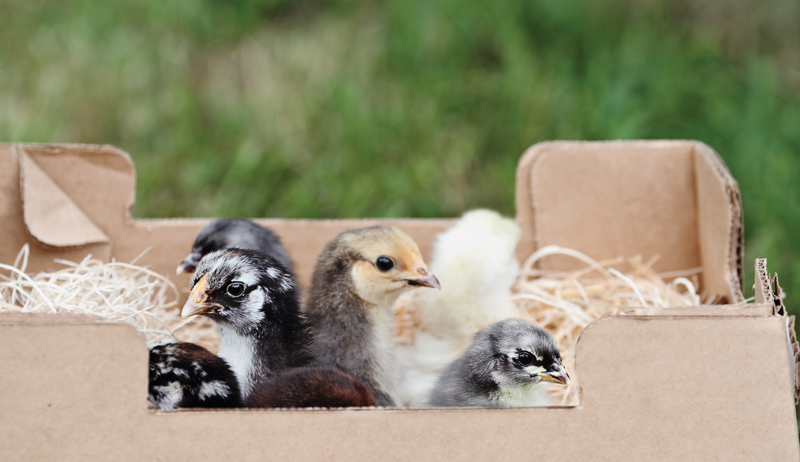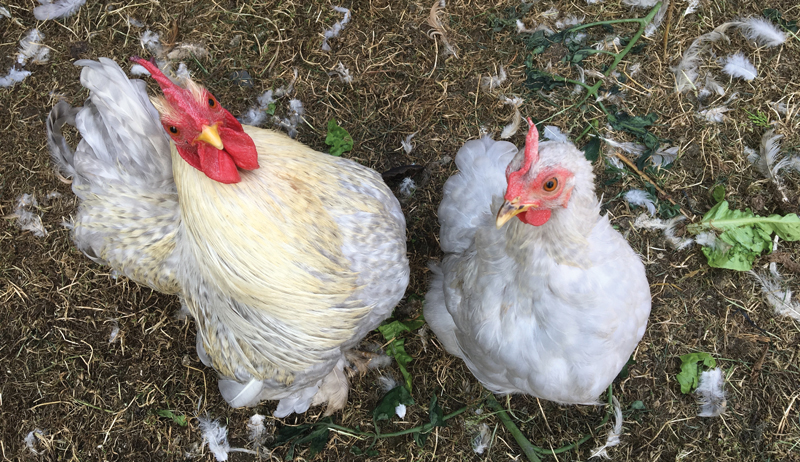
Some people love math; others hate it. However, it turns out that our schoolteachers were right: We all need it. Even when we’re keeping chickens, it all starts with the numbers: It’s chicken math.
Not the storied chicken math affliction of no self-control where you set out to raise a certain number of chickens, let’s say 10, then suddenly you’re saying things like “a few more won’t make a difference” and you find yourself with 30 birds in your backyard.
Chicken math involves the numbers that really count toward making sure you have a happy and healthy flock. Let’s take a look at the numbers that make chicken-keeping successful.
Flock Size
3
New chicken-keepers often ask how many chickens they should get. This of matter chicken math is a personal number based on household egg consumption, backyard space, time and even money.
But the real decision often comes down to where and how you purchase your birds.
Chickens are not solitary animals and need to be kept in a flock. For that reason, the absolute minimum of day-old chickens you can normally buy from a hatchery or farm-supply store is three birds at a time.
Beware that many places require purchases of more than three birds at a time. Always check before you buy! You can always split an order with a friend or two.
At farm-supply stores, the base minimum is usually six birds at a time. This means even if you bought six birds from the same store three days ago, if you change your mind and want a few more, you’ll have to start with purchasing six again.
If you’re having chicks shipped, the base number will be determined by how many birds it’s safe to ship. This can vary depending on the time of year and your location.
Minimums often go up in the colder months because more bodies equal more heat.
Minimums can also depend on what you’re purchasing. Large fowl minimums may be less than bantam minimums.
Check how your chosen hatchery will keep your chicks warm during shipping. Some have heat packs you can purchase to add in the box.
If you decline to spend the extra money but still want a smaller order, some hatcheries will fill that box space—think heat—with sexed day-old roosters.
Yes, you get your smaller order, but you’re also stuck with roosters.
Follow this advice when adding new birds to your flock.
10
Ten is a number that often represents perfection, and it’s no different in the world of chicken math. A good ratio for a multi-sexed flock is 10 hens for every rooster.
In a large farm flock, people don’t worry too much about rooster ratios. The roosters all work out their pecking order, and the flock moves forward.
In backyard settings, the ideal ratio of roosters to hens is worth considering. Backyard space is limited, which can lead to aggression as a rooster defends his flock and territory from real or perceived threats.
Too many roosters can also lead to over mating, causing the hens damage.
Is this a hard and fast rule? No. Some find keeping more hens with one rooster is better and go above 10. Others don’t want or can’t keep a larger flock and find their flock does well with a smaller ratio.
Breeders also keep more roosters to hens.
If you do want to keep more than one rooster, you can increase the chances they’ll get along if they are raised together or if you add a young rooster when you’re adding new pullets.
Don’t forget, roosters will work out a pecking order between themselves. This can lead to fights and injury so birds should be monitored and chicken keepers should be prepared to intervene.

Housing Requirements
4
Whether you’re starting with your first coop or building a new one, you’ve got to know how much room, minimum square feet per bird inside the coop, that your chickens need.
Four square feet is what’s needed for a heavy chicken such as a Brahma. You can reduce to 3 feet for midweight and lightweight birds and 2 square feet for bantams.
It’s safest to err on the larger side. Too small and you invite problems with cleanliness and behavior such as pecking.
10
Chickens need fresh air and sun to be at their healthiest. If your chickens can’t safely free-range all day, then you’ll need an outside run that’s attached to the coop.
The rule of thumb for a run is 8 to 10 square feet per bird. Of course, this is an area where bigger is definitely better, so feel free to go beyond the minimums!
4
Chickens need nest boxes where they can lay their eggs. This is important so the eggs are easy to find for the chicken-keeper and are laid in a clean spot.
The recommended number of nest boxes is one for every four to five hens with 1 square foot of space inside the box.
Mind you, chickens don’t read the recommendations, so you’ll probably find they all favor one box and will squabble over the coveted space with some piling into the box even if it’s occupied.
Don’t reduce the box number in this case, just know you’re offering them the spaces to use or not. It’s entirely their choice.
Subscribe to our newsletter & have stories like this delivered to your inbox!
Raising Chicks
21
It takes 21 days for a chicken egg to hatch. If your broody hen is sitting on eggs, it’s a good idea to mark her eggs with the day they are laid, then mark your calendar.
Eggs will usually hatch in 21 days, but hatch can happen after that, so don’t be too quick to throw out eggs if they haven’t hatched yet.
Other notable hatching lengths include turkey and duck eggs that take 28 days to hatch and Muscovy ducks eggs that take 35 days to hatch.
95
If you’re hand-raising day-old-chicks, this is the number you’re going to concentrate on for their first week of life in the brooder. This should be the temperature on the floor of the brooder, so make sure your thermometer is placed near the floor where the chicks are located to get an accurate reading.
The brooder temperature should be reduced by five degrees each week until the brooder is the same temperature as the air.
It’s always good to keep an eye on your chicks in the brooder. If they are chirping and dispersed through the area eating and scratching, then their temperature is just right.
If they are chirping loudly and huddled together, the temperature may be too low. Too hot and they will pant and move away from the heat source.
If you use a heat plate in your brooder, there’s no need for a formal thermometer. The chicks will go under the heat plate as needed. Just make sure the indoor room temperature isn’t too cold.
(I use a brooder plate and keep my brooder in the house between 71 to 73 degrees.)

75
This is the minimum temperature recommended for first visits outside by your brooder chicks. In the beginning, chicks are not able to regulate their body temperature, so weeks 4 and 5 are best for starting some excursions outdoors.
Use common sense with outside visits. Be sure baby chicks are in a safe, confined area and able to escape the elements.
If it gets colder, windy, rainy or even too sunny, take the chicks inside to their brooder. Be sure they have food and water during their visit outdoors.
Adult Birds
16
At 16 weeks old, pullets (a female chicken under a year of age) are old enough to begin laying eggs. This important point of chicken math is technically called the point of lay, and it can vary by individual chicken and breed. Sixteen weeks is on the early side of egg-laying.
The average is between 16 to 20 weeks or even longer.
Remember that chicks raised in the fall will likely not begin to lay until spring, but when they do lay, their eggs will be bigger and more consistently sized than a first-time spring layer.
Sixteen to 18 weeks is also the time starter/grower feed should be switched to layer feed.
Feed your flock for less with these 7 budget-conscious tips.
18
At 18 months old, chickens go through their first molt, when they lose old feathers and replace them with new feathers.
This happens in late summer and fall as daylight hours trigger molting. It’s preparation for winter as new feathers offer more warmth and protection during the cold.
Molts come in two types: hard and soft. When a soft molt happens, you may not even notice it because feathers are lost and replaced gradually.
It’s difficult to miss a hard molt because your bird loses tons of body feathers all at once. During molting, hens will decrease or stop laying eggs altogether. Both hens and roosters molt and it can take up to 12 or more weeks to finish.
12
Egg laying is influenced by the number of available daylight hours. The minimum amount of light needed for hens to lay eggs is 12 hours; 14 to 16 hours is ideal.
If you do supplement your chicken’s light during the winter to maintain egg production, it’s recommended to replace the light in the morning. This helps chickens settle naturally with the fading daylight, so no one’s stuck on the floor when the light suddenly goes out.
Make sure your chickens are finished with their fall molt before you add extra light.

24
It takes between 24 and 26 hours for a hen to produce an individual egg. Most of that time, 20 hours, in fact, is spent forming the egg’s shell.
The time line starts with a mature ova, or yolk, being released into the oviduct. The egg white is then added followed by the shell membranes.
After that, the shell is formed (egg color is added in the last five hours), the bloom is added and the egg is laid.
4
An individual eggshell contains four grams of calcium; two grams come from a hen’s diet, the other two come from a hen’s medullary bones.
57
The number of large-fowl chicken breeds recognized by the American Poultry Association is 57, and the number of bantam chicken breeds is 67. Within those breeds, there are hundreds of different varieties.
If you’re raising a flock of backyard chickens, does this matter? Probably not.
If you’re looking to breed or show your birds, this is important. The APA defines a breed as “an established group of individuals possessing similar characteristics and, when mated together, produce offspring with those same characteristics.”
Examples of popular breeds are Brahma, Java, Orpington, Australorp, Sussex and Wyandotte.
Learn more about the Australorp, a chicken-keeping favorite!
Harold S. Geneen (1910-1997), an American businessman who served as the CEO of IT&T Corp., wrote in his book, Managing, that “When you have mastered the numbers, you will in fact no longer be reading numbers any more than you read words when reading a book. You will be reading meanings.”
We’re not sure if that applies to chicken math, but it certainly adds up!
This article originally appeared in the March/April 2020 issue of Chickens magazine.




